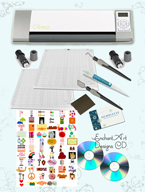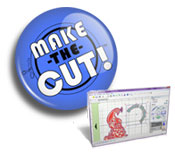You can trace an image and convert that image from .jpeg or .bmp into a file that can be used by your digital cutter machine (like Quikutz Silhouette). Please follow these steps:
- Click on File and Import. Look for your image, click on it to select it and click on Open.
- You should be able to see your image now. Click on it to select it. Reposition or enlarge the image if necessary.
- Click on Path, Trace Bitmap. The Trace Bitmap window will open.
- You will see two tabs on the Trace Bitmap window (Mode and Options).
- On the Mode tab, you can play and change the settings until you find the one that is giving you the best outline. Remember that you have an Update button at the bottom right corner of the window. Preview your results until you are happy. If your outline is too weak, try a higher setting; if it’s too strong , try a lower one.
- When you click OK, you have already traced the image.
- Now click on the image and, without letting go of your left mouse button, drag the image to the side.
- With the traced image still selected, click on View, Display Mode, Outline.
Congratulations, you did it!!!. If you want to, now you can save it. Go to File, Save As and choose the extension .DXF
If you want to make the lines softer, you can simplify the nodes of your image. Click on the second icon from the toolbox, the one that says “edit path nodes…” when you put your mouse over. Click on Path and Simplify .
To cut your design, you need to open your software from your digital cutter machine, click on File and select Load DFX. Change anything that you want and save it as a GSD file.
I really hope this tutorial can help you. Remember to experiment and have fun in the process.
Tags: how to trace an image using Inkscape, Inkscape tutorial, Quickutz Silhouette, wishblade





this explains tracing very clearly
[…] Tracing an Image using Inkscape http://enchantart.com/blog/?p=187 […]